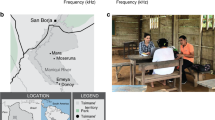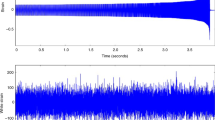Abstract
INCIDENTAL reference was made to the “eerie electric crackle” of auroras recently1 by a writer from Unst, the most northerly island of Shetland. A correspondent2 who had spent several winters in the Arctic and Antarctic dismissed this crackle as “an auricular illusion well known to polar explorers”. But others3–7 reported that sound (described as “crackling” or “swishing”) is indeed associated with auroras. This is widely believed by people living in regions where auroras are common8.
This is a preview of subscription content, access via your institution
Access options
Subscribe to this journal
Receive 51 print issues and online access
$199.00 per year
only $3.90 per issue
Buy this article
- Purchase on Springer Link
- Instant access to full article PDF
Prices may be subject to local taxes which are calculated during checkout
Similar content being viewed by others
References
Jones, T., The Times, March 5 (1973).
Riley, Q., The Times, March 8 (1973).
Johnston, A., The Times, March 22 (1973).
Kaye, C. W., The Times, April 5 (1973).
Brown, P. L., The Times, April 11 (1973).
Thomas, E., The Times, April 16 (1973).
Lea, H., The Times, April 19 (1973).
Elvey, C. T., Adv. Electronics Electron Phys., 9, 1 (1957).
Chapman, S., Nature, 128, 457 (1931).
Beals, C. S., Q. Jl R. met. Soc., 59, 71 (1933).
Jelstrup, H. S., Nature, 119, 45 (1927).
Tjø nn, T., cited by Störmer, C., in Nature, 141, 955 (1938) and in The Polar Aurora (Clarendon Press, Oxford, 1955).
Campbell, W. H., and Young, J. M., J. geophys. Res., 68, 5909 (1963).
Harang, L., The Aurorae (Chapman and Hall, London, 1951).
Chapman, S., in Aurora and Airglow (edit. by McCormac, B. M.) (Reinhold, New York, 1967).
Sverdrup, H. E., Nature, 128, 457 (1931).
Störmer, C., Nature, 119, 46 (1927).
Simpson, G. C., Q. Jl R. met. Soc., 59, 185 (1933).
Buneman, O., Phys. Rev. Lett., 10, 285 (1963).
Farley, D. T., J. geophys. Res., 68, 6083 (1963).
Lord Rayleigh, Theory of Sound (second ed.) (Macmillan, London, 1894).
Dalgarno, A., in Auroral Phenomena (edit. by Walt, M.) (Stanford University Press, 1965).
Cole, A. E., Court, A., and Kantor, A. J., in Handbook of Geophysics and Space Environments (edit. by Valley, S. L.) (McGraw-Hill, New York, 1966).
Stephens, R. W. B., and Bate, A. E., Acoustics and Vibrational Physics (second ed.) (Edward Arnold, London, 1966).
Chrzanowski, P., Greene, G., Lemmon, K. T., and Young, J. M., J. geophys. Res., 66, 3727 (1961).
Wilson, C. R., and Nichparenko, S., Nature, 214, 1299 (1967).
Wilson, C. R., Nature, 216, 131 (1967).
Author information
Authors and Affiliations
Rights and permissions
About this article
Cite this article
BATES, D. Auroral Audibility. Nature 244, 217–218 (1973). https://doi.org/10.1038/244217a0
Received:
Revised:
Published:
Issue Date:
DOI: https://doi.org/10.1038/244217a0
Comments
By submitting a comment you agree to abide by our Terms and Community Guidelines. If you find something abusive or that does not comply with our terms or guidelines please flag it as inappropriate.



